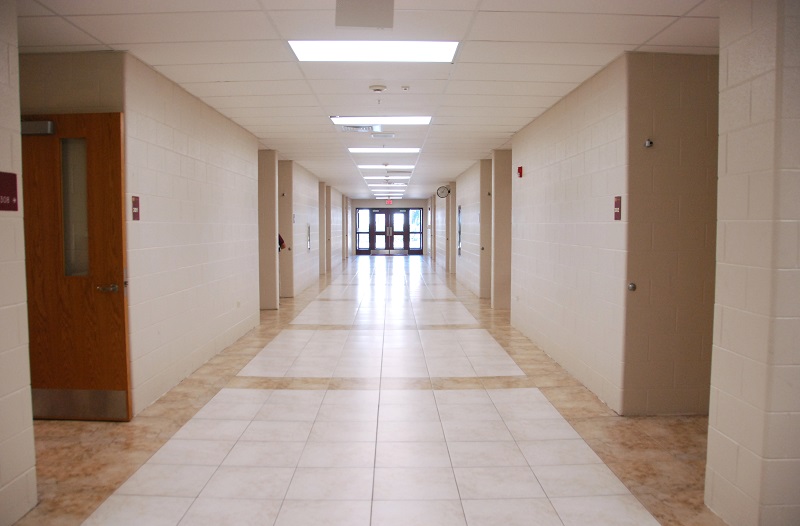Corridor
A corridor is a form of hallway or gallery which is typically narrow in comparison to its lenght and acts as a passage connecting different parts of a building. A corridor often has entry points to rooms along it.
Despite being a normal feature of many modern buildings, corridors did not become common until the late-17th century, and were only first used widely in the 19th century. Prior to the use of corridors as a means of circulation, people would simply flow from one room into the next.
It has been theorised that the proliferation of corridors was driven to a certain extent by socio-economic factors and evolving moral attitudes. Corridors were a means of separating the occupants of a building, such as servants from those they served, inmates from the prison guards, workers from supervisors, and so on. They created privacy, in that it was no longer necessary to go through rooms, it was only necessary to go in to them.
Corridors also helped increase the efficiency with which people could move through buildings, while also turning rooms into a series of dead ends by separating circulation from destination.
The design of corridors is largely determined by the functions of the building. Hospital corridors will need to be wide enough to allow bi-directional flow of traffic, including beds and wheelchairs. Hotel corridors need to be robust enough for suitcase wheels, trolleys, and so on. Corridors may need access to natural light from windows, or be lit well artificially so as to avoid dark corners and allow easy circulation.
However, they can sometimes be soulless 'between' spaces, with no particular character or function, anonymous decoration, poor-quality artificial light and the feel of a prison offering nothing but a series of locked cell doors.
The world’s longest corridor is in RAF Mount Pleasant on the Falkland Islands. Nicknamed the ‘Death Star Corridor’, it is half a mile (800 m) long, and links the barracks, messes, and recreational/welfare areas of the station.
There are a number of statutory requirements for the design of corridors. Part M of the building regulations sets standards for circulation spaces so as to make them accessible, this includes required widths to allow circulation by people in wheelchairs. Part B of the building regulations sets standards for fire safety; corridors may form part of escape routes, with required minimum widths, and may be protected corridors, that is, corridors which are protected from fire in adjoining accommodation by fire-resisting construction.
For more information see: Approved document M and Approved document B.
[edit] Other meanings
The word corridor might also be used to refer to:
- A transport corridor, such as a railway corridor.
- A wildlife corridor.
- A green corridor.
- A view corridor.
- Corridor management.
[edit] Related articles on Designing Buildings
- Ancillary area.
- Arcade.
- Blind arcade.
- British post-war mass housing.
- Changing lifestyles in the built environment.
- Cloister.
- Colonnade.
- Corridor management.
- Green corridor.
- Lobby.
- Loggia.
- Narthex.
- Protected escape route.
- Railway corridor.
- Space classifications for lighting controls.
- View corridor.
- Wildlife corridor.
Featured articles and news
One of the most impressive Victorian architects. Book review.
RTPI leader to become new CIOB Chief Executive Officer
Dr Victoria Hills MRTPI, FICE to take over after Caroline Gumble’s departure.
Social and affordable housing, a long term plan for delivery
The “Delivering a Decade of Renewal for Social and Affordable Housing” strategy sets out future path.
A change to adoptive architecture
Effects of global weather warming on architectural detailing, material choice and human interaction.
The proposed publicly owned and backed subsidiary of Homes England, to facilitate new homes.
How big is the problem and what can we do to mitigate the effects?
Overheating guidance and tools for building designers
A number of cool guides to help with the heat.
The UK's Modern Industrial Strategy: A 10 year plan
Previous consultation criticism, current key elements and general support with some persisting reservations.
Building Safety Regulator reforms
New roles, new staff and a new fast track service pave the way for a single construction regulator.
Architectural Technologist CPDs and Communications
CIAT CPD… and how you can do it!
Cooling centres and cool spaces
Managing extreme heat in cities by directing the public to places for heat stress relief and water sources.
Winter gardens: A brief history and warm variations
Extending the season with glass in different forms and terms.
Restoring Great Yarmouth's Winter Gardens
Transforming one of the least sustainable constructions imaginable.
Construction Skills Mission Board launch sector drive
Newly formed government and industry collaboration set strategy for recruiting an additional 100,000 construction workers a year.
New Architects Code comes into effect in September 2025
ARB Architects Code of Conduct and Practice available with ongoing consultation regarding guidance.
Welsh Skills Body (Medr) launches ambitious plan
The new skills body brings together funding and regulation of tertiary education and research for the devolved nation.
Paul Gandy FCIOB announced as next CIOB President
Former Tilbury Douglas CEO takes helm.
























Comments
[edit] To make a comment about this article, click 'Add a comment' above. Separate your comments from any existing comments by inserting a horizontal line.